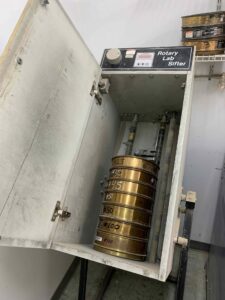Last week we learned about a little bit about sieve analysis and the aggregate 200 wash. Today, we’ll focus on sieving fine and coarse aggregate – particles larger than the No. 200 sieve.
The Importance of Sieve Analysis Testing
Sieve analysis, or gradation testing, is a way to assess the particle size distribution of material. The aggregate material is put through a series of progressively smaller sieves, and the amount “caught” at each sieve size is weighed as a fraction of the material’s whole mass. Why is this important? Since aggregate is a key component in most concrete mixtures, it is vital to be sure the aggregate is appropriate for what it is being used for. The structural integrity of the road or bridge or foundation or whatever is being built depends on it. Fine and coarse aggregate generally occupies 60% to 75% of the concrete volume.
Coarse aggregate is that which will not fit through a No. 4 (4.75mm) sieve; fine aggregate passes through the 9.5mm sieve and is completely retained at the No. 200 sieve.
Aggregate Grading
After the aggregate is sampled and the moisture content determined, the sample is weighed. It is important that the aggregate be dry; otherwise, it may clump and clog up the sieve. (At this point, the aggregate 200 wash has already been performed to remove the finest particles and soluble materials such as salt from the sample.)
Applications and Insights
Prior to testing, the sieves must be cleaned with a wire brush to ensure that nothing remains from previous samples. The desired sieves are then placed in what is called a sieve nest. The nest of ASTM-specified sieves is placed on the mechanical shaker, with the sieve with the largest openings at the top and the sieve with the smallest openings at the bottom. The mechanical shaker agitates the nest, moving the aggregate progressively down through the sieves. The smallest pieces fall to the bottom, and the largest stay in the upper sieves, separated by particle size. When the sorting is complete, the mass weight of each sample size increment is measured and recorded, and a grain size distribution curve graph can be created.
Let Encorus sort your aggregate! Call Jeremy Lake at 716.592.3980, ext. 133, or email jlake@encorus.com.



